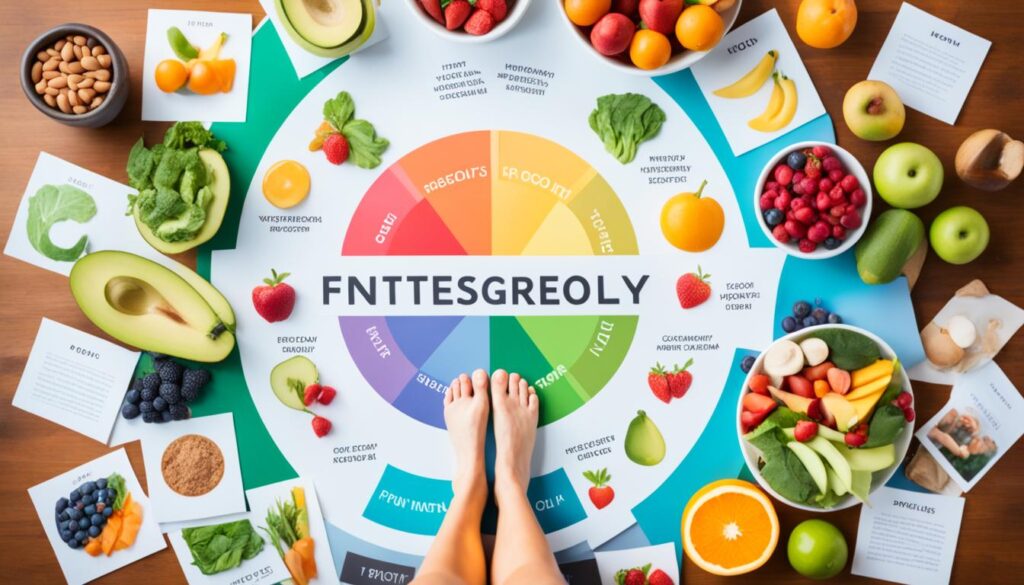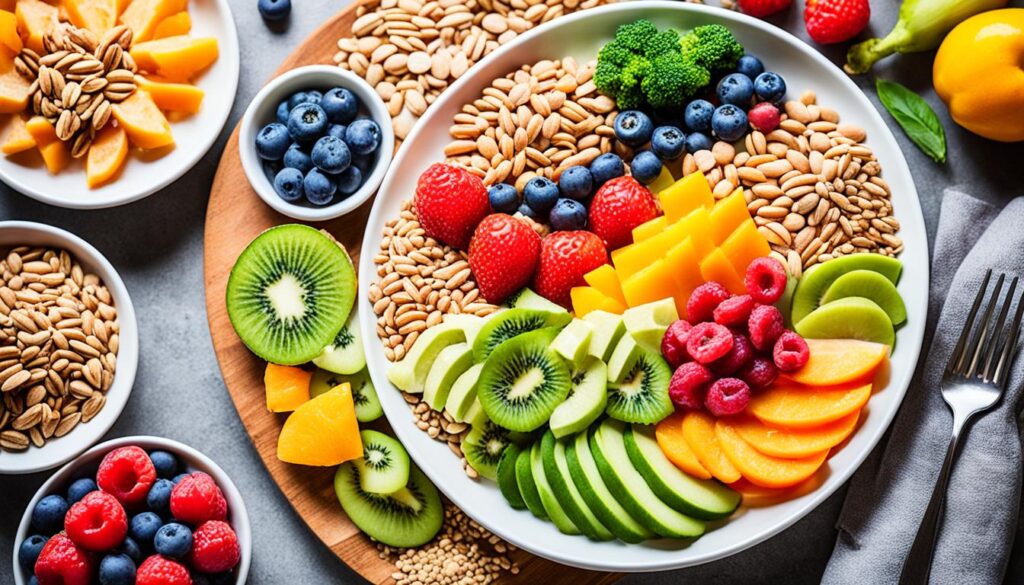Starting a weight loss journey can be thrilling and tough at the same time. With the right steps, you can reach your goals safely and in a lasting way. This guide offers you effective strategies and tips to lose weight while keeping your health and well-being first.
If you want to lose a few pounds or more, this article has what you need. It gives you the knowledge and tools to meet your goals. By learning about weight loss basics, setting realistic goals, and living a balanced life, you’re on your way to a healthier, happier you.
Key Takeaways
- Understand the basics of weight loss, including calorie deficit and metabolism
- Set realistic and achievable weight loss goals
- Create a balanced and nutritious diet plan with guidance on macro and micronutrients
- Incorporate regular exercise into your routine for optimal fat burning and muscle building
- Develop a positive mindset and self-care practices to stay motivated and overcome challenges
Understanding the Fundamentals of Weight Loss
To lose weight, you need to understand the basics. At the heart of it is the calorie deficit. This means eating fewer calories than you burn. It’s all about balance.
Calorie Deficit and Metabolism
Your metabolism is how your body turns food into energy. It’s key for losing weight. When you eat less than your body needs, it uses stored fat for energy. This is how you safely lose weight.
The Role of Diet and Exercise
- A good diet helps you eat fewer calories without losing energy or health.
- Exercise boosts fat-burning and keeps muscle mass. This helps your metabolism too.
Knowing these weight loss basics helps you make a plan that fits your life. This way, you can succeed for the long term.
“Sustainable weight loss is not about quick fixes or fad diets – it’s about making lifestyle changes that become second nature.”
| Calorie Deficit | Metabolism | Diet | Exercise |
|---|---|---|---|
| The key to weight loss is creating a calorie deficit, where you burn more calories than you consume. | Your metabolism determines how efficiently your body converts food into energy, affecting your ability to lose weight. | A well-balanced diet tailored to your needs can help you achieve the necessary calorie deficit. | Regular exercise, including both cardiovascular and strength training, boosts fat-burning and muscle maintenance. |
Setting Realistic and Achievable Goals
Starting with clear and realistic weight loss goals is key to a healthier life. When setting weight loss goals, make sure they are achievable for you. This makes success more likely and helps you keep going long-term.
To set realistic weight loss goals, follow these steps:
- Start with small, easy targets. Losing 1-2 pounds a week is safe and works well.
- Use your current weight, body type, and health to set goals. A healthcare pro can help find a healthy weight for you.
- Have both short and long-term goals. Losing 5–10 pounds at first can make you feel great and keep you motivated.
- Think about non-scale wins, like more energy, better sleep, and more physical strength, along with weight loss.
- Check and change your goals as needed, based on your life changes or progress.
By setting achievable weight loss goals, you start a lasting journey to a healthier, happier life. Remember, lasting success comes from a balanced approach that values your overall health.

“The journey of a thousand miles begins with a single step.” – Lao Tzu
Creating a Balanced and Nutritious Diet Plan
For sustainable weight loss, you need a diet plan that balances macronutrients and micronutrients. Understanding proteins, carbohydrates, fats, vitamins, and minerals helps you make a balanced diet for weight loss. This diet nourishes your body and supports your fitness goals.
Macro and Micronutrient Guidance
Keep an eye on macronutrients like proteins, carbohydrates, and fats to get the right nutritious diet plan for you. Proteins build and maintain muscle, carbohydrates give you energy, and healthy fats support hormone production and brain function. Vitamins and minerals are key for metabolism, immune function, and health.
Portion Control and Meal Prepping
Controlling your portions is crucial for achieving your weight loss goals. By measuring and distributing macronutrients and micronutrients through meal prepping, you can keep a calorie deficit and get the nutrients your body needs. Meal planning and prep make sticking to a healthy diet easier.
| Macronutrient | Recommended Daily Intake | Benefits |
|---|---|---|
| Protein | 0.8-1.2 g per kg of body weight | Supports muscle growth and maintenance, keeps you feeling full |
| Carbohydrates | 45-65% of total daily calories | Provides energy, supports brain function, and regulates blood sugar |
| Fats | 20-35% of total daily calories | Supports hormone production, brain health, and nutrient absorption |
Focus on a balanced diet for weight loss with the right macronutrients and micronutrients. Add strategic portion control and meal prepping for long-term weight loss success.

Incorporating Regular Exercise into Your Routine
Regular exercise is key for losing weight and staying healthy. Mixing cardio and strength training helps burn fat and build muscle. This makes you look and feel better.
Cardiovascular Exercises for Fat Burning
Activities like walking, jogging, cycling, and swimming are great for losing fat. They make your heart work harder, burning calories during and after exercise. Try to do at least 150 minutes of moderate cardio or 75 minutes of intense cardio each week for the best results.
Strength Training for Muscle Building
Adding strength training for muscle building to your routine is also important. It helps shape a lean body. Use weights, your own body, or resistance bands to work out. Try to exercise like this two to three times a week, focusing on all your muscles.
| Exercise Type | Benefits | Frequency |
|---|---|---|
| Cardiovascular | Burn calories and improve heart health | 150 minutes moderate or 75 minutes vigorous per week |
| Strength Training | Build muscle and boost metabolism | 2-3 times per week |
By doing both cardio and strength exercises, you’ll get closer to your weight loss goals. You’ll also keep a healthy, toned body.

Weight-loss, Weight-loss goals, and Losing weight safely
Starting a weight-loss journey can change your life, but it’s key to do it right. We’ll look into weight loss, setting goals, safe ways to lose weight, and getting to a healthy weight.
Weight loss isn’t the same for everyone. Everyone’s body and metabolism are different. But there are some basic ideas that help with safe and effective weight loss.
Setting realistic and achievable weight loss goals is key to success. These goals should be clear, measurable, and match your health and wellness goals. Trying to lose 1-2 pounds each week is a good, safe pace.
It’s also important to focus on safe and healthy weight loss methods. This means eating well, staying active, and avoiding quick fixes or extreme diets that aren’t good for you.
The goal is more than just reaching a certain weight. It’s about living a life that makes you feel good, inside and out. By taking a whole-life approach to managing your weight, you can really benefit from a healthy weight-loss journey.
| Weight Loss Goals | Safe Weight Loss | Healthy Weight |
|---|---|---|
| Specific, measurable, and achievable targets | Gradual, steady weight loss (1-2 lbs/week) | Optimal body composition and overall wellness |
| Aligned with overall health and wellness | Balanced and nutrient-dense diet | Sustainable lifestyle changes |
| Foundational for long-term success | Regular physical activity | Improved physical, mental, and emotional well-being |
Remember, losing weight and getting to a healthy weight is a personal journey. It’s important to find what works for you. With the right mindset, support, and effort, you can meet your weight loss goals safely and effectively.

Staying Motivated and Overcoming Plateaus
Keeping up motivation is key when you’re trying to lose weight. It’s important to use both practical tips and a positive outlook to stay on track. Let’s look at how to keep going and beat weight loss plateaus for lasting success.
One great way to stay motivated is to celebrate your progress. Whether it’s fitting into smaller jeans or seeing a good number on the scale, celebrate your wins, big or small. This positive feedback can give you the boost you need to keep going.
Weight-loss plateaus can be tough, but they’re normal. To get past them, try new workouts, change your diet, or talk to a health expert. Keep pushing forward and focus on the journey, not just the end. This mindset can help you get through tough times.
- Set achievable, short-term goals to stay motivated
- Track your progress and celebrate your successes
- Experiment with different exercise and nutrition strategies to overcome plateaus
- Maintain a positive mindset and focus on the long-term benefits of your efforts
Using these tips will help you reach your weight-loss goals and keep healthy habits for life. The journey has ups and downs, but with the right attitude and plan, you can beat any challenge.
“The secret of getting ahead is getting started. The secret of getting started is breaking your complex overwhelming tasks into small manageable tasks, and then starting on the first one.” – Mark Twain
Developing a Positive Mindset and Self-Care Practices
Reaching your weight loss goals is more than just about changing your body. It’s also about building a positive mindset and taking care of yourself. By focusing on a positive mindset for weight loss and using self-care for weight loss methods, you can greatly improve your path to better health.
Mindfulness and Stress Management
Being mindful is a crucial part of losing weight successfully. It means being fully in the moment, noticing your thoughts, feelings, and body without judging them. Adding mindfulness, like meditation or deep breathing, can help you handle stress better and lessen its bad effects on your weight loss.
Too much stress can hurt your weight-loss efforts. It might lead to eating more, sleeping poorly, and weakening your immune system. Learning good stress management ways can help you control your feelings and make better health choices.
- Try regular meditation or mindfulness to stay calm and focused.
- Look into relaxation methods, like yoga, deep breathing, or muscle relaxation, to keep stress down.
- Make time for self-care activities that make you happy and help you relax, such as reading, taking a warm bath, or enjoying nature.
Putting a focus on a positive mindset and self-care practices lays a strong base for your weight loss journey. This ensures lasting success and a healthier, more balanced life.
“The greatest weapon against stress is our ability to choose one thought over another.” – William James
Addressing Common Challenges and Setbacks
No weight-loss journey is easy. You’ll face challenges and setbacks, like cravings and emotional eating. These can make it hard to keep going. But, with the right tools, you can beat these challenges and reach your weight-loss goals.
Cravings can be a big problem. You might want a sugary snack or a big plate of comfort food. To fight cravings, try eating healthier foods, drinking plenty of water, and using stress-relief methods like deep breathing or meditation.
Emotional eating is another hurdle. We might eat when we’re stressed, bored, or just happy. To deal with this, know what makes you eat emotionally and find better ways to handle those feelings. This could be writing in a journal, talking to a friend, or doing something active.
- Recognize your emotional eating patterns and triggers
- Find alternative ways to cope with stress, boredom, or other emotions
- Seek support from friends, family, or a professional if needed
Life events or travel can also make it hard to stick to your weight-loss plan. Be flexible and adaptable. Bring healthy snacks when you travel, and try to fit in exercise, even if it’s not your usual routine.
| Challenge | Solutions |
|---|---|
| Cravings |
|
| Emotional Eating |
|
| Lifestyle Disruptions |
|
Remember, overcoming weight-loss challenges and dealing with weight-loss setbacks is part of the journey. Being ready and having a plan helps you get past these hurdles. This way, you can keep moving towards your health and fitness goals.
Maintaining Weight-Loss Long-Term
Reaching your weight-loss goals is a big win, but keeping that weight off is harder. It’s key to make changes that you can keep up with, not just quick fixes. This way, you won’t fall back into old habits.
Lifestyle Changes and Sustainable Habits
To keep your weight off, make lasting habits part of your life. This means:
- Following a diet full of whole foods.
- Staying active with cardio, strength training, and flexibility exercises.
- Watching your portion sizes and listening to your body.
- Putting self-care first, like managing stress and sleeping well.
Remember, maintaining weight loss is a journey, not a goal. By sticking to these habits, your hard work will pay off for years.
“The secret of getting ahead is getting started. The secret of getting started is breaking your complex overwhelming tasks into small manageable tasks and then starting on the first one.”
For long-term weight loss, focus on sustainable weight-loss habits. Make small, steady changes and care for your health. This way, you’ll keep the weight off for good.
Conclusion
In this guide, we’ve covered key strategies for safe and effective weight loss. You now have the tools to start a journey towards better health and wellness. This includes understanding weight loss basics, setting achievable goals, and making a diet and exercise plan.
We’ve stressed the need for a sustainable weight-loss approach. This means focusing on your overall health, not just quick results. By making lasting lifestyle changes, you can reach your weight goals and keep up with healthy habits.
Remember, the main thing is to be patient, consistent, and flexible as you move forward. You might hit roadblocks, but with the right mindset and strategies, you can get past them. Stay motivated, celebrate your wins, and enjoy the path to a healthier, happier life.
























